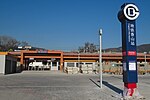Jingtai Mausoleum

The Jingtai Mausoleum (Chinese: 景泰陵; pinyin: Jǐngtàilíng) is the mausoleum of the Jingtai Emperor, the seventh emperor of the Ming dynasty. It is located in the Haidian District, 17 km northwest of central Beijing, and is situated north of Jingming Park. After the Tumu Crisis of 1449, the Jingtai Emperor placed his brother, the former Emperor Yingzong, under house arrest in the Forbidden City. In 1457, Emperor Yingzong took the throne after a conspiracy and the Jingtai Emperor died shortly thereafter. At the time of his death, the Jingtai Emperor had almost completed his tomb at the Ming tombs where his ancestors were buried. However, Emperor Yingzong completely destroyed the tomb. Instead, Jingtai was buried as a prince along with Empress Wang north of Yuquan Mountain at the foot of the Western Mountains in the northwestern outskirts of Beijing. During the reign of the Chenghua Emperor (r. 1464–1487), the tomb was upgraded to an imperial tomb.The original and long-unused tomb of the Jingtai Emperor was rebuilt in 1621 as Qingling Mausoleum, where the Taichang Emperor was buried in the same year.Compared to the other imperial tombs from the Ming dynasty, Jingtai Mausoleum is smaller. The remains of the tomb are in very poor condition and the area where it is located now serves as a residential area for retired military personnel.
Excerpt from the Wikipedia article Jingtai Mausoleum (License: CC BY-SA 3.0, Authors, Images).Jingtai Mausoleum
遗光寺路, Haidian District Qinglongqiao
Geographical coordinates (GPS) Address Nearby Places Show on map
Geographical coordinates (GPS)
| Latitude | Longitude |
|---|---|
| N 40.0023 ° | E 116.23624444444 ° |
Address
景泰陵
遗光寺路
100093 Haidian District, Qinglongqiao
Beijing, China
Open on Google Maps










